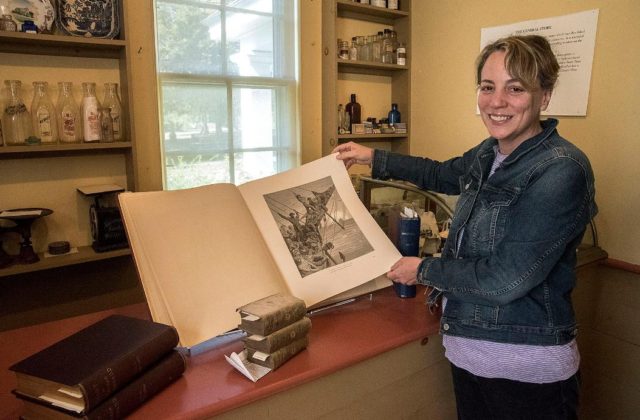Bibliomania: The Passion for Books and for Collecting Them
New exhibition opening at the Historical Society Museum
By Ruth Melville
Photo, top, of curator Lucy Mookerjee at the Norfolk Historical Society, by Bruce Frisch.
In the late 18th century, a popular hobby, especially among English gentlemen, scholars and clergymen, was collecting books. In his 1809 book “Bibliomania; or Book Madness,” the English bibliographer Thomas Dibdin satirized this contemporary craze. Professing to offer a cure for the supposedly pathological obsession with book collecting, Dibdin managed both to genially lampoon bibliomania and to encourage its popularity.
The cultivated families of Norfolk in the period 1790-1830 were not immune to the collecting “disease.” The Robbins, Battell and Eldridge families all amassed sizable collections of notable books, many of which were later given to the Norfolk Historical Society and the Norfolk Library, where they are kept in the Rare Books Room. This fall the Historical Society Museum and the library are displaying a selection of these often rare and beautiful books, including some that have never been shown in public before. The exhibit is curated by Lucy Mookerjee and Barry Webber.
The genealogy of book collecting in Norfolk starts with the patriarch of the family, Ammi R. Robbins. His daughter Sarah married Joseph Battell. Robbins and Battell were both avid collectors, as was Robbins’s son Thomas. Thomas left his collection, considered one of the major intact libraries of the period, to the Connecticut Historical Society.
In the next generation, Sarah and Joseph Battell’s son-in-law Reverend Joseph Eldridge carried on the book-collecting tradition. But even more important for the bibliographical history of Norfolk, Eldridge and his wife, Sarah Battell Eldridge, had a daughter Isabella, who in 1889 founded the Norfolk Library in honor of her parents. Isabella Eldridge gave many of the books in her family’s collection, including those of her father and of her uncle Azariah Eldridge, to the newly founded library.
A variety of attributes made a book “collectible,” for example, the size of the volume or the quality and profusion of its illustrations. Among the books that will be on display is an 1877 edition of Samuel Taylor Coleridge’s “The Rime of the Ancient Mariner,” with illustrations by Gustave Doré. Another volume in the exhibit with notable illustrations is “The Mansions of England in the Olden Times,” by Joseph Nash.
Some collectors tried to gather as many different editions of a particular title as they could find. An example in the Norfolk exhibit is a set of three editions of William Cowper’s “Poems,” dated 1809, 1814, and 1816. Pocket-sized miniature books were also much sought after, and the exhibition includes Isabella Eldridge’s personal tiny bible.
Mookerjee’s favorite book in the exhibit is a copy of the sixth edition of Samuel Johnson’s “Dictionary of the English Language,” the edition that includes his last corrections. This copy, which was owned by Joseph Battell, has a double cover: a leather cover over a paper cover, which has been marbleized to look like calf. As with stamp collecting, a mistake in the printing—in this edition of the “Dictionary,” one page number is wrong—made the book even more covetable to bibliomaniacs. Dibdin defines this as “a true edition,” one that has a small variation or defect that makes it more, not less, desirable by bibliomaniacal collectors.
In his book, Dibdin suggested several cures for bibliomania, including opening literary institutions, which is indeed exactly what Isabella Eldridge chose to do. So it is fitting that also on display at the museum will be another gift from Isabella, not a book this time, but the gown that she wore on March 6, 1889, for the official opening of the Norfolk Library.
The exhibit has been planned to coincide with the Haystack Book Festival, which takes place the first weekend of October. The Historical Society Museum will be open on Saturday, 10 a.m. to 5 p.m., and Sunday, 12 to 4 p.m. There will be an opening reception on Friday, Oct. 4, from 4 to 6 p.m. During the weekend, the copy of “Rime of the Ancient Mariner” will be open, and pages will be turned throughout the day so that visitors can see more of the Doré illustrations.

